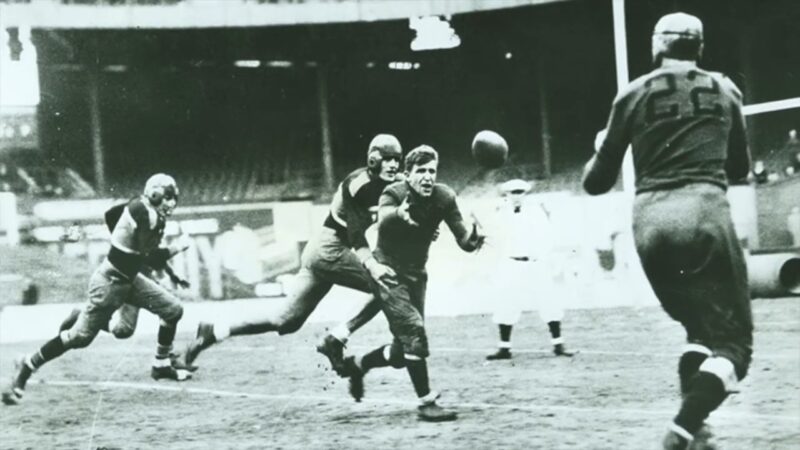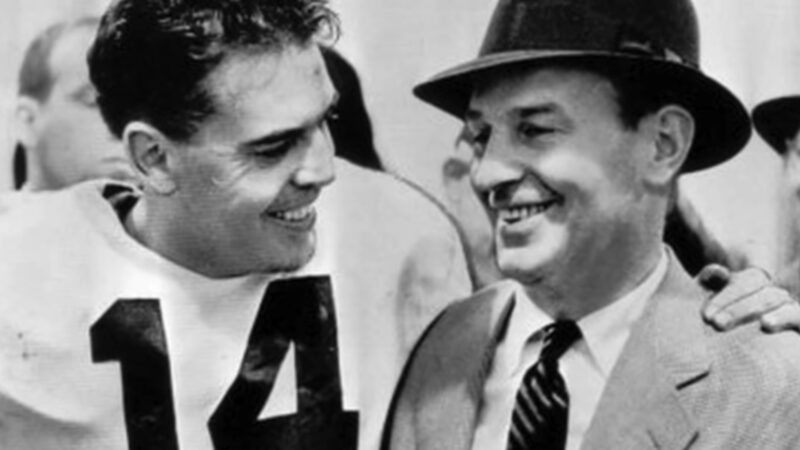Welcome to the history of NFL Free Agency. Buckle up as we take you on a journey through the evolution of player contracts, rules, and the freedom to move between teams. This blog post aims to make complex information easily digestible for all, so let’s get started!
The Reserve Rule (1920-1946)

The Reserve Rule was the cornerstone of NFL player contracts from 1920 to 1946. It was the first system that governed how players could move—or rather, couldn’t move—between teams.
The Rule’s Mechanics
The Reserve Rule was simple but restrictive. It allowed teams the right to re-sign a player indefinitely. Each player’s contract had a clause that enabled the team to continually re-sign the player to one-year contracts with the same terms as their previous contract. This meant players had only three options:
- Play for the same team
- Get traded
- Retire
Impact on Players
This rule was a double-edged sword. On one hand, it provided job security for players. On the other hand, it severely limited their freedom and bargaining power. Players were bound to one team and couldn’t negotiate with others, making them de facto “property” of the team.
The One Year Option Rule (1947-1962)

In 1947, the NFL decided it was time for a change and introduced the “One Year Option Rule.” This rule was a small step toward what we now know as free agency.
The Rule’s Mechanics
Under this rule, teams had the right to use a reserve clause only once after a player’s contract expired. The option year couldn’t contain the reserve clause, giving players the freedom to negotiate with any team after playing out their option year. This was the first time players could become free agents without restrictions.
Impact on Players
The first player to benefit from this rule was 49ers wide receiver R.C. Owens. After his option year in 1961, Owens became a free agent and signed a new contract with the Baltimore Colts. This move set a precedent and showed players that they had more control over their careers.
If you want to find out more about fifth-year option take a look at our article.
The Rule’s Legacy
The One Year Option Rule was revolutionary for its time. It paved the way for unrestricted free agency, giving players more freedom and bargaining power. However, it was just the beginning, and more changes were on the horizon.
The Rozelle Rule (1963-1976)

Named after then-NFL Commissioner Pete Rozelle, the Rozelle Rule came into effect in 1963. This rule was a response to the newfound freedom players had gained, and it aimed to balance the scales back in favor of the teams.
The Rule’s Mechanics
The Rozelle Rule allowed the NFL Commissioner to award compensation to a team losing a free agent. The compensation could be in the form of players, draft choices, or cash. This rule was part of the collective bargaining agreement and was accepted by the NFL Players Association (NFLPA).
Impact on Players
The rule significantly deterred teams from signing free agents, as they were uncertain about the compensation they might have to give up. This decreased players’ bargaining power and restricted their ability to sell their services on the open market.
Legal Challenges
In 1976, the NFLPA challenged the Rozelle Rule in court in the case Mackey v NFL. The court found the rule to be an unreasonable restraint on trade, violating Section 1 of the Sherman Act. This landmark case led to the rule’s eventual demise and set the stage for the next chapter in NFL free agency.
The Right of First Refusal and Compensation (1977-1988)
After the fall of the Rozelle Rule, the NFL and the NFLPA had to come up with a new system. The result was the Right of First Refusal and Compensation system, which came into effect in 1977.
The Rule’s Mechanics
Under this system, a free agent’s original team had the right to match any contract offer from another team, effectively giving them the “right of first refusal.” If the original team chose not to match the offer, they were entitled to draft choice compensation from the team signing their player. The level of compensation was structured based on the player’s experience and new salary.
Impact on Players
This rule was a mixed bag for players. On one hand, they could negotiate with other teams, but on the other hand, their original team could easily retain them by matching the offer. This system still restricted player movement to some extent but was less stringent than its predecessors.
The Rule’s Legacy
The Right of First Refusal and Compensation system was a transitional phase in the evolution of NFL free agency. It was a compromise that allowed some level of player movement while still giving teams a way to retain their key players. The system was tweaked in the 1982 collective bargaining agreement to better align draft compensation with multiple tiers of salaries.
Plan B Free Agency (1989-1992)
In 1989, with legal battles still looming, the NFL owners imposed what was known as Plan B Free Agency. This was a unilateral decision made in the absence of a labor agreement.
The Rule’s Mechanics
Under Plan B, teams could protect up to 37 of their players from becoming free agents. These protected players were subject to the same old compensation rules if signed by another team. However, unprotected players were free to negotiate and sign with any team without any restrictions.
Impact on Players
This led to a significant increase in player movement, but it was mostly among the less-heralded players. The top 37 players on each team were still restricted, which meant that star players had limited freedom.
The Rule’s Legacy
Plan B was a step toward modern free agency, but it was far from perfect. It was a temporary measure that lasted only a few years but set the stage for more significant changes. Only one restricted player, linebacker Wilber Marshall, changed teams under this system.
The First Glimpse of NFL Free Agency (1992)

The year 1992 was a watershed moment in NFL history. A U.S. District Court ruling temporarily made four players unrestricted free agents, offering a glimpse of what was to come.
The Rule’s Mechanics
Judge David Doty ruled that four players were to become unrestricted free agents for five days. This was a temporary measure until an evidentiary hearing could be conducted.
Impact on Players
Three of the four players—Keith Jackson, Webster Slaughter, and Garin Veris—signed contracts with new teams. This was a monumental moment that showed what could happen if players were given true freedom.
The Rule’s Legacy
This ruling was a precursor to the more comprehensive changes that would come the following year. It showed both players and owners the potential impact of unrestricted free agency, setting the stage for the landmark White v. NFL case.
NFL Free Agency (1993-Present)
The year 1993 marked a seismic shift in the NFL landscape. The White v. NFL case led to the “White Settlement,” ushering in the era of modern free agency. This was a game-changer for both players and teams.
The Rule’s Mechanics
Under the new system, any veteran with at least five years of experience (later reduced to four) could become an unrestricted free agent. Teams could also designate one “Franchise” player, restricting their movement on the market. Additionally, “Transition” players could be named in the first and final two years of the Collective Bargaining Agreement (CBA), offering another layer of restriction.
Impact on Players
For the first time, players had significant freedom to test the market and sign with any team. This not only increased their bargaining power but also led to more competitive balance within the league. Teams could no longer hoard talent indefinitely.
The Rule’s Legacy
The modern era of free agency has been a win-win for both players and teams. Players have gained unprecedented freedom and earning potential, while teams have been forced to be smarter and more strategic in building their rosters. This has led to a more exciting and unpredictable NFL landscape.
Restricted and Exclusive Rights Free Agents
While unrestricted free agency was a significant leap forward, the system also included provisions for restricted and exclusive rights free agents, adding complexity to player movement.
The Rule’s Mechanics
Players with three or four seasons of experience were subject to the same right of first refusal/compensation system as before. Teams also had exclusive negotiating rights for players with fewer than three years of experience, known as exclusive rights free agents.
Impact on Players
These categories provided a balanced approach to free agency. While star players could command high salaries as unrestricted free agents, younger and less experienced players still had some restrictions, ensuring that teams could retain emerging talent.
The Rule’s Legacy
This multi-tiered approach to free agency has added depth and strategy to team-building. It allows teams to plan for both the short-term and long-term, making roster management a year-round endeavor.
Frequently Asked Questions
What is a “Transition” Player?
A “Transition” player is a free agent who receives a one-year contract from his original team that is worth the average of the top 10 salaries at his position. Unlike a “Franchise” player, a “Transition” player can negotiate with other teams, but his original team has the right to match any offer.
How often can a player be tagged as a “Franchise” player?
A player can be tagged as a “Franchise” player for up to three consecutive years by his original team. However, the cost of tagging a player increases significantly each year, making it a less viable option for teams to use repeatedly.
What is a “Tender” in restricted free agency?
A “Tender” is a one-year contract offer that a team extends to a restricted free agent. The level of the tender determines the draft pick compensation that another team would have to give up to sign the player.
What is the “Legal Tampering” period?
The “Legal Tampering” period is a 48-hour window before the start of free agency when teams can negotiate with the agents of impending free agents. However, no contracts can be officially signed until free agency begins.
How does the Salary Cap impact free agency?
The Salary Cap is the maximum amount of money that a team can spend on player salaries in a given year. Teams must manage their cap space wisely to sign free agents while also retaining their own key players.
Final Words
We’ve journeyed through the evolution of NFL Free Agency, exploring its rules, impact, and legacy. It’s a complex system, but one that has shaped the NFL into the dynamic, competitive league we love today.
